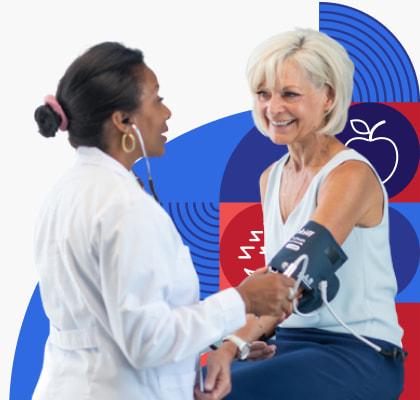Doctor Visits
Get Your Blood Pressure Checked

The Basics
Overview
Nearly half of all adults in the United States have high blood pressure. High blood pressure raises your risk for serious health problems, including stroke and heart attack.
Get your blood pressure checked regularly starting at age 18 years — and do your best to keep track of your blood pressure numbers.
How often do I need to get my blood pressure checked?
- If you’re age 40 years or older, or if you’re at higher risk for high blood pressure, get your blood pressure checked at least once a year.
- If you’re age 18 to 39 years and you aren’t at higher risk for high blood pressure, get your blood pressure checked at least every 3 to 5 years. Consider asking your doctor if you should get it checked more often than that.
What puts me at higher risk for high blood pressure?
Your risk for high blood pressure goes up as you get older. You’re also at higher risk for high blood pressure if you:
- Are African American
- Have overweight or obesity
- Are currently pregnant or had high blood pressure during a past pregnancy
- Don’t get enough physical activity
- Drink too much alcohol
- Smoke
- Don’t eat a healthy diet
- Have kidney failure, diabetes, or some types of heart disease
Learn more about your risk for high blood pressure.
What is blood pressure?
Blood pressure is how hard your blood pushes against the walls of your arteries. Arteries are the tubes that carry blood away from your heart. Every time your heart beats, it pumps blood through your arteries to the rest of your body.
What is hypertension?
Hypertension is the medical term for high blood pressure. High blood pressure usually has no symptoms, so it’s sometimes called a “silent killer.” The only way to know if you have high blood pressure is to get it checked.
How Blood Pressure is Measured
What do blood pressure numbers mean?
A blood pressure test measures how hard your heart is working to pump blood through your body.
Blood pressure is measured with 2 numbers. The first number (called systolic blood pressure) is the pressure in your arteries when your heart beats. The second number (called diastolic blood pressure) is the pressure in your arteries when your heart relaxes between beats.
Compare your blood pressure to these numbers:
- Normal blood pressure is lower than 120/80 (said as “120 over 80”)
- High blood pressure is 130/80 or higher
- Blood pressure that’s between normal and high (for example, 125/80) is called elevated blood pressure
If your blood pressure is elevated, it means you’re at risk for developing high blood pressure. Talk to your doctor and make a plan to control your blood pressure.
Learn more about what your blood pressure numbers mean.
How can I get my blood pressure checked?
To test your blood pressure, a nurse or doctor will put a cuff around your upper arm. The nurse or doctor will pump the cuff with air until it feels tight, then slowly let it out. This takes just a few minutes.
You can find out what your blood pressure numbers are right after the test is over. If the test shows that your blood pressure is high, ask the doctor what to do next.
Blood pressure can go up and down, so it’s a good idea to get it checked more than once.
Can I check my blood pressure by myself?
Yes. You can buy a home blood pressure monitor at a drug store. Many shopping malls, pharmacies, and grocery stores also have blood pressure machines you can use in the store.
If the test shows that your blood pressure is elevated or high, talk to your doctor and make a plan to control it.
If you have high blood pressure, your doctor might ask you to monitor your blood pressure at home to keep track of your numbers — and to see if treatments are working.
Check out these resources:
Pregnancy
How can high blood pressure affect pregnancy?
If you’re pregnant, high blood pressure can be dangerous for you and your baby. If you have high blood pressure and you want to get pregnant, it’s important to take steps to lower your blood pressure first.
Sometimes women get high blood pressure for the first time during pregnancy. This is called gestational hypertension. This type of high blood pressure usually goes away after the baby is born — but you may have a higher risk of getting high blood pressure in the future.
If you have high blood pressure while you’re pregnant, be sure to visit your doctor regularly. To learn more:
High Blood Pressure
What if I have high blood pressure?
If you have high blood pressure, work with your doctor to make a treatment plan to control it. Your treatment plan may include healthy life changes, medicine, or a combination of both.
These steps can help lower your blood pressure:
- Eat healthy, including foods such as fruit, vegetables, and whole grains, and limiting foods high in saturated fat and sodium (salt). Check out the DASH eating plan to help lower blood pressure.
- Get active — aim for 150 minutes a week of moderate-intensity aerobic activity. Use this resource to get more physical activity.
- Manage your weight by eating healthy and getting active. Learn how to stay at a healthy weight.
- Remember to take medicines as prescribed (ordered) by your doctor. Learn more about blood pressure medicines.
Small changes can add up. For example, losing just 10 pounds can help lower your blood pressure.
Take Action
Get It Checked
Start by getting your blood pressure checked as soon as possible. You can’t “feel” high blood pressure, so the only way to know if your blood pressure is elevated or high is to get it checked. Once you know your blood pressure numbers, you can take steps to prevent or lower high blood pressure.
Check your blood pressure regularly.
Make sure a doctor or nurse checks your blood pressure at your next visit. Write down your blood pressure numbers so you'll remember them. Print out or save this list of questions to ask your doctor about blood pressure.
You can also find blood pressure machines at many shopping malls, pharmacies, and grocery stores. Most of these machines are free to use. Print this tool to keep track of your blood pressure [PDF - 663 KB].
If you want to check your blood pressure at home, you can buy a home blood pressure monitor at a drug store. Learn how to check your blood pressure at home.
What about cost?
Under the Affordable Care Act, insurance plans must cover blood pressure testing. Depending on your insurance plan, you may be able to get your blood pressure checked by a doctor or nurse at no cost to you. Check with your insurance company to find out more.
Medicare also covers blood pressure testing at no cost as part of your yearly wellness visit. Learn more about Medicare wellness visits.
If you don’t have insurance, you may still be able to get free or low-cost blood pressure tests. Find a health center near you and ask about getting your blood pressure checked.
To learn more, check out these resources:
Eat Healthy
Eat less sodium.
Eating less sodium (salt) can lower your blood pressure. When you go food shopping, check the Nutrition Facts label for the Daily Value (DV) of sodium. Choose foods with a DV of 5% or less. Foods with a DV of 20% or more are high in sodium. Foods that are often higher in sodium include processed meats, frozen meals (like pizza and ready-to-eat meals), packaged foods, and canned soups or broths.
Get more tips to:
Choose a mix of healthy foods.
Eating a mix of healthy foods can help prevent high blood pressure — and help control your blood pressure if it’s already high. Choose a variety of:
- Fruits — like apples, berries, oranges, and mango
- Veggies — like broccoli, sweet potatoes, beets, okra, peppers, and jicama
- Whole grains — like brown rice, millet, oatmeal, bulgur, and whole-wheat bread
- Healthy proteins — like lean meats and chicken, seafood, beans and lentils, nuts and seeds, and tofu
- Low-fat or fat-free dairy or dairy alternatives — like milk, yogurt, cheese, lactose-free dairy, and fortified soy beverages (soy milk) or soy yogurt
- Vegetable oils — like olive and canola oil
Try to limit foods that:
- Are high in saturated fat — like fatty meats, full-fat dairy, and tropical oils like coconut and palm oil
- Have added sugars — like sugar-sweetened drinks, desserts, and many breakfast cereals
Eating more potassium can also help lower your blood pressure. Good sources of potassium include potatoes, spinach, bananas, beans, and yogurt.
Check out these tips to eat healthier with the DASH eating plan (Dietary Approaches to Stop Hypertension).
Healthy Habits
Manage your weight.
A healthy diet and physical activity can help you control your weight — and your blood pressure. If you have overweight or obesity, losing weight can lower your risk for high blood pressure.
Get tips to help you aim for a healthy weight.
Get active.
Getting regular physical activity can lower your risk of high blood pressure. Aim for at least 150 minutes a week of moderate-intensity aerobic activity a week, like:
- Walking fast
- Dancing
- Riding bikes
- Swimming
- Aerobics
Check out this information on getting active.
Drink alcohol only in moderation.
If you choose to drink alcohol, drink only in moderation. That means 1 drink or less in a day for women and 2 drinks or less in a day for men.
Get more information about drinking alcohol in moderation.
Manage your stress.
Managing stress can help prevent and control high blood pressure. Deep breathing and meditation are good ways to relax and manage stress.
Check out these tips on managing stress.
Quit smoking.
Smoking damages your heart and blood vessels. Quit smoking to help lower your risk of high blood pressure, stroke, and heart disease.
Content last updated May 1, 2025
Reviewer Information
This information on blood pressure was adapted from materials from the Centers for Disease Control and Prevention and the U.S. Preventive Services Task Force.
Reviewed by:
Alison Brown
Program Director
National Heart, Lung, and Blood Institute
National Institutes of Health
Young Oh
Program Officer
National Heart, Lung, and Blood Institute
National Institutes of Health
Paula Einhorn
Program Officer
National Heart, Lung, and Blood Institute
National Institutes of Health


